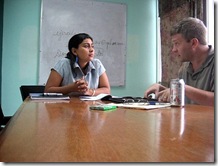 For nearly a year, I’ve been taking private tutoring at ISC Panama in Panama City. I usually take 4-6 hours of private instruction each week.
For nearly a year, I’ve been taking private tutoring at ISC Panama in Panama City. I usually take 4-6 hours of private instruction each week.
I’ve had several different professors. Some have been excellent, one or two I haven’t clicked with. They have been helpful to me in working with me to translate my teaching material into Spanish, and helpful in some of the finer points of Spanish.
So, two or three times a week, I walk to class. The building is about 6 long blocks away and for the most part, the walk is enjoyable, particularly if I listen to my IPOD as I go. I listen to sermons from Ravi Zacharais, or Mark Driscoll, as well as leadership development podcasts.
The DELE Exam
I will continue to take and pay for classes at this school. I have a new professor and she is helping me specifically prepare for the DELE exam, an internationally recognized certification

DELE is the official test in Spanish as a foreign language and stands for Spanish Diploma as a Foreign Language (Diplomas de Español como Lengua Extranjera). The Instituto Cervates (the official governmental organization who promotes the Spanish language) is the organization in charge of the DELE Spanish language exams. The DELE Spanish language test is also internationally recognized as the official Spanish language exam for non-native Spanish language speakers (like the TOEFL test is for the English language).
I am planning on taking the 2nd level, or intermediate level.
The second Spanish language course level is the intermediate (Nivel Intermedio) which is for students who are able to understand and speak the Spanish language in every day situations and who have a good knowledge of the Spanish grammar.
The Spanish language exam for all levels consists of 5 different parts where the main difference of the 3 levels is the difficulty and the time available for each part.
The first part is to examine the Spanish language reading comprehension of the student and consists of a Spanish text which will vary in length and difficulty. After having read the Spanish text the student has to answer a number of multiple choice questions about the text.
The second part is to test the Spanish language written skills of the student and consists of writing a small text or an essay depending on the Spanish level.
The third part is a Spanish language listening exercise where the student has to answer a number of questions after having heard a Spanish text.
The fourth part is to test the students’ knowledge of Spanish language grammar and Spanish language vocabulary and consists of multiple choice questions and filling out blank spaces with appropriate Spanish words.
The fifth part is the oral test where the student has to talk to a Spanish examiner for about 10-15 minutes about a picture or a specific topic.
Prayer Request
Continue to pray for me as I prepare and make this investment in our future ministry in Latin America. I am preparing to take this test in the Spring of 2009 as the November 2008 dates will not work in my schedule.
Leave a Reply